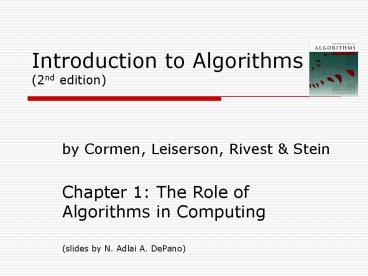Introduction to Algorithms (2nd edition) - PowerPoint PPT Presentation
Title:
Introduction to Algorithms (2nd edition)
Description:
The Human Genome Project seeks to identify all the 100,000 genes in human DNA, ... chemical base pairs comprising human DNA, storing this information in databases, ... – PowerPoint PPT presentation
Number of Views:61
Avg rating:3.0/5.0
Title: Introduction to Algorithms (2nd edition)
1
Introduction to Algorithms(2nd edition)
- by Cormen, Leiserson, Rivest Stein
- Chapter 1 The Role of Algorithms in Computing
- (slides by N. Adlai A. DePano)
2
Algorithms
Informally, an algorithm is
A well-defined computational procedure that takes
some value, or set of values, as input and
produces some value, or set of values, as output.
A sequence of computational steps that transform
the input into output.
3
Algorithms
Empirically, an algorithm is
A tool for solving a well-specified computational
problem.
Problem specification includes what the input is,
what the desired output should be.
Algorithm describes a specific computational
procedure for achieving the desired output for a
given input.
4
Algorithms
The Sorting Problem
Input A sequence of n numbers a1, a2, ,
an. Output A permutation or reordering a'1,
a'2, , a'n of the input sequence such that
a'1 ? a'2 ? ? a'n .
An instance of the Sorting Problem
Input A sequence of 6 number 31, 41, 59, 26,
41, 58.
Expected output for given instance
ExpectedOutput The permutation of the input
26, 31, 41, 41, 58 , 59.
5
Algorithms
Some definitions
An algorithm is said to be correct if, for every
input instance, it halts with the correct output.
A correct algorithm solves the given
computational problem.
Focus will be on correct algorithms incorrect
algorithms can sometimes be useful.
Algorithm specification may be in English, as a
computer program, even as a hardware design.
6
Gallery of Problems
Algorithms are needed (most of which are novel)
to solve the many problems listed here
7
Gallery of Problems
8
Some algorithms
- Shortest path algorithm
- Given a weighted graph and two distinguished
vertices -- the source and the destination --
compute the most efficient way to get from one to
the other - Matrix multiplication algorithm
- Given a sequence of conformable matrices, compute
the most efficient way of forming the product of
the matrix sequence
9
Some algorithms
- Convex hull algorithm
- Given a set of points on the plane, compute the
smallest convex body that contains the points - String matching algorithm
- Given a sequence of characters, compute where (if
at all) a second sequence of characters occurs in
the first
10
Hard problems
- Usual measure of efficiency is speed
- How long does an algorithm take to produce its
result? - Define formally measures of efficiency
- Problems exist that, in all probability, will
take a long time to solve - Exponential complexity
- NP-complete problems
- Problems exist that are unsolvable
11
Hard problems
- NP-complete problems are interesting in and of
themselves - Some of them arise in real applications
- Some of them look very similar to problems for
which efficient solutions do exist - Knowing the difference is crucial
- It is not known whether NP-complete problems
really are as hard as they seem, or, perhaps, the
machinery for solving them efficiently has not
been developed just yet
12
Hard problems
- P ? NP conjecture
- Fundamental open problem in the theory of
computational complexity - Open now for 30 years
13
Algorithms as a technology
- Even if computers were infinitely fast and memory
was plentiful and free - Study of algorithms still important still need
to establish algorithm correctness - Since time and space resources are infinite, any
correct algorithm would do - Real-world computers are fast but not infinitely
so - Memory is cheap but not unlimited
14
Efficiency
- Time and space efficiency are the goal
- Algorithms often differ dramatically in their
efficiency - Example Two sorting algorithms
- INSERTION-SORT time efficiency is c1n2
- MERGE-SORT time efficiency is c1nlogn
- For which problem instances would one algorithm
be preferable to the other?
15
Efficiency
- Answer depends on several factors
- Speed of machine performing the computation
- Internal clock speed
- Shared environment
- I/O needed by algorithm
- Quality of implementation (coding)
- Compiler optimization
- Implementation details (e.g., data structures)
- Size of problem instance
- Most stable parameter used as independent
variable
16
Efficiency
- INSERTION-SORT
- Implemented by an ace programmer and run on a
machine A that performs 109 instructions per
second such that time efficiency is given by - tA(n) 2n2 instructions (i.e., c12)
- MERGE-SORT
- Implemented by a novice programmer and run on a
machine B that performs 107 instructions per
second such that time efficiency is given by - tB(n) 50nlogn instructions (i.e., c150)
17
Efficiency
Machine BMerge- Sort
Machine AInsertion- Sort
Problem Size
n 2n2/109 50nlogn/107
10,000 0.20 0.66
50,000 5.00 3.90
100,000 20.00 8.30
500,000 500.00 47.33
1,000,000 2,000.00 99.66
5,000,000 50,000.00 556.34
10,000,000 200,000.00 1,162.67
50,000,000 5,000,000.00 6,393.86
18
Efficiency
- Graphical comparison
19
Algorithms vis-à-vis other technologies
- Are algorithms really that important in the face
of dramatic advances in other technologies? - Hardware superfast clock speeds, parallelism,
pipelining - Graphical User Interfaces (GUI)
- Object Oriented Systems
- LANs and WANs
- YES! Algorithms are at the core of most
technologies used in contemporary computation































